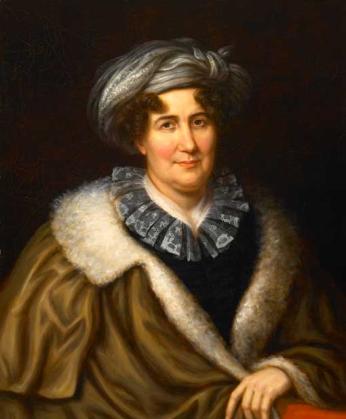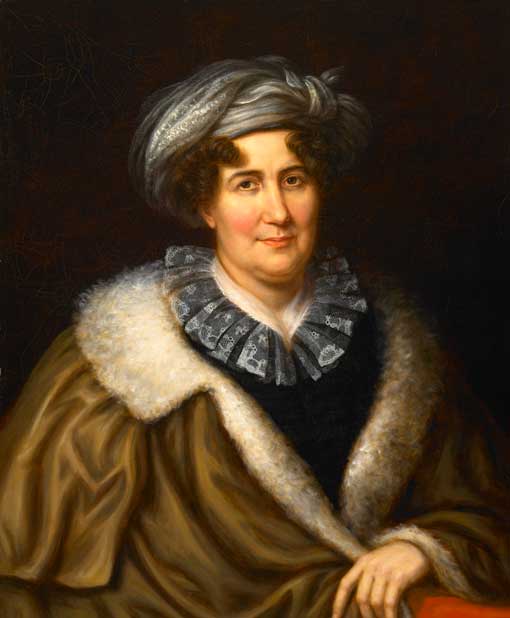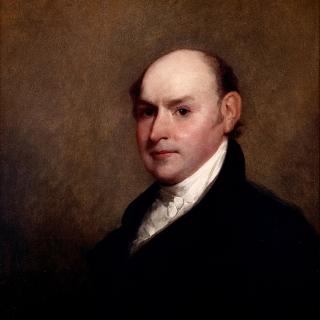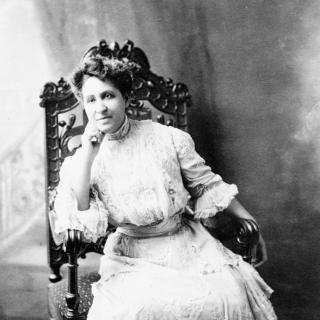Margaret Bayard Smith: A Writer of Washington
In 1906, J. Henley Smith published a collection of letters that excited historians of early America. Smith was the grandson of Samuel Harrison Smith, the writer and publisher of The National Intelligencer—established in 1800, it was Washington, D.C.’s first newspaper. But Smith wasn’t celebrating the literary legacy of his famous grandfather. The letters and papers in this collection actually belonged to his grandmother, Margaret Bayard Smith.
Samuel and Margaret Smith moved to Washington in 1800, while the city was still being built around them. As the publishers of the local newspaper, they were accepted into the social circles that surrounded the new country’s government, where they rubbed shoulders with some of the most notable figures of early American politics. They became particularly close with President Thomas Jefferson, whose politics they supported in the Intelligencer—but Margaret also befriended Dolley Madison, the undisputed queen of Washington society. The Smiths’ interactions with these famous names are described in the many letters Margaret wrote to her family and friends, making them invaluable resources for historians. It’s something that J. Henley Smith recognized when he published The First Forty Years of Washington Society, an edited collection of Margaret’s writings. He “selected only those letters which give an intimate view of the social life of Washington,” from a collection of “several thousand of my grandmother’s letters…from nearly all the prominent characters of her day.”[1]
Anyone who reads The First Forty Years will form an image of Margaret as a lively social butterfly and busybody. After all, her published letters seem like the nineteenth-century equivalent of a gossip column—and she certainly used her powers of observation to enrich articles in the Intelligencer. What readers may not realize is that, just like her husband, Margaret was an accomplished writer. In nineteenth-century Washington, she was well-known as an author in her own right, not just a socialite.
Margaret began writing early in life. Her words first appeared in print in 1800, when she wrote to The Monthly Magazine, and American Review—written around the time of her wedding, when she was twenty-two.[2] Over the next decades, she submitted letters and writings to numerous other publications—and it’s easy to guess that she made several contributions to the Intelligencer, before her husband sold the newspaper in 1810. Margaret clearly had the talent and the voice. Unfortunately, she felt the need to conceal her identity. All of her early works are written anonymously—or else, under simple and nondescript pseudonyms, like “S.”[3] Many of them have since been identified, thanks to the work of historians like Fredrika Teute, but Margaret’s contemporaries may not have been fully aware of just how opinionated she was.
Better known were Margaret’s novels, published in the 1820s: A Winter in Washington and What is Gentility? These were also anonymous, but it was common knowledge who the author was—in Washington, at least.[4] Margaret drew on her experiences in Washington’s ballrooms and drawing rooms, creating a fictionalized but witty portrait of her world. Think Jane Austen, but in D.C. Margaret also understood the potential of her residency in Washington, using it to convey messages of hope and American strength to readers across the country—especially women. She published a detailed account of Thomas Jefferson’s inauguration for Lady’s Book, a popular woman’s magazine, as well as her adventures visiting his home at Monticello.[5] In 1836, she was asked to create a biographical sketch of her friend Dolley Madison for the National Portrait Gallery of Distinguished Americans.
But throughout her literary career, Margaret seems to have struggled with the societal expectations for wealthy, well-known women. As the historian Cassandra Good notes, Margaret’s personal notebooks are filled with musings that directly contradict her public persona.[6] For one thing, she actually detested attending all those parties and gatherings. “To me that society is barren of enjoyment,” she wrote in 1806, “where the heart & mind find neither exercise nor expansion.”[7] She preferred spending time at the Smiths’ home on the outskirts of Washington, where she educated her children and worked on her writing. In her diaries, where she was free to express her true self, she also reveals her frustration for domestic tasks, her dislike of slavery, her interest in African American education, all the books of philosophy she wants to read, and the limited opportunities for artistic expression.[8] Yet Margaret knew that, to be taken seriously as a female writer, she had to adapt a more socially acceptable role—in this case, a mere observer of political life. There’s a reason why the majority of her sharper, more opinionated writings were published anonymously.
For a modern reader, a better portrait of Margaret’s literary mind comes in 1831, when she submitted the piece “My Books” to a woman’s magazine. In its basic form, the piece is an ode to her collection of books and the attic room where she works. On a deeper level, we can see how trapped Margaret must have felt—only here, in “a room exclusively my own,” without the interruptions of social and domestic life, could she realize her full potential.[9] A century later, the British author Virginia Woolf famously expressed these same feelings—despite the fact that, most likely, she never heard of Margaret Bayard Smith.[10]
And yet, when J. Henley Smith published The First Forty Years, he believed that he was revealing his grandmother’s greatest legacy:
“Undoubtedly Mrs. Smith’s most interesting and valuable writings were those which she never intended for publication and which have hitherto never seen the light, being her private letters, in which she opens an intimate view of the famous political characters in Washington…those letters present a picture highly entertaining and valuable…”[11]
Margaret’s role in history has, so far, been as an observer of more interesting people—the great men (and occasional women) of American legend. Technically, it was a role that she created for herself. But it allows us to overlook her true experience as a woman, writer, and political player in early D.C.
Footnotes
- ^ J. Henley Smith, “Prefatory Note,” in The First Forty Years of Washington Society, ed. Gaillard Hunt (New York: Charles Scribner’s Sons, 1906), viii-ix.
- ^ Fredrika J. Teute, “In ‘the gloom of evening’: Margaret Bayard Smith’s View in Black and White of Early Washington Society,” in Proceedings of the American Antiquarian Society 106, Part 1 (1996): 37.
- ^ Teute, 38.
- ^ Ibid.
- ^ Smith, “Prefatory Note,” vi.
- ^ Cassandra Good, “’A Transcript of my Heart’: The Unpublished Diaries of Margaret Bayard Smith, in Washington History 17 (Fall/Winter 2005): 66-82.
- ^ Good, 68.
- ^ Good, 66-70.
- ^ Good, 69.
- ^ Ibid.
- ^ Smith, “Prefatory Note,” vii-viii.






![Sketch of the mythical fuan by Pearson Scott Foresman. [Source: Wikipedia]](/sites/default/files/styles/crop_320x320/public/2023-10/Goatman_Wikipedia_Faun_2_%28PSF%29.png?h=64a074ff&itok=C9Qh-PE1)












